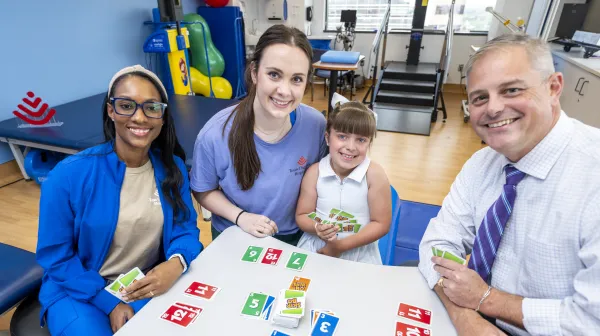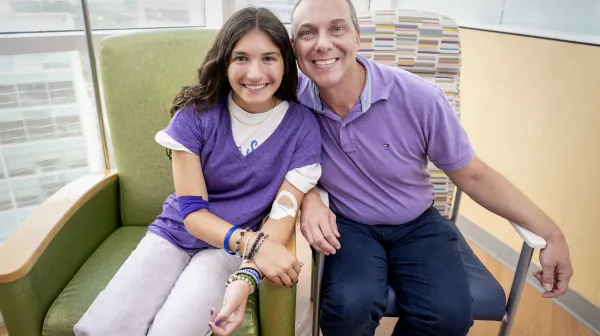
Photo courtesy of Victoria Macias
Malia Macias is a happy, healthy and energetic 9 year old. She loves school, meeting new friends and has big dreams to become a veterinarian one day. For this ambitious fourth grader, the possibilities are endless. Her mom, Victoria, is reminded every day of her daughter’s strength, bravery and perseverance. The first few years of Malia’s life weren’t easy—they were filled with many ups and downs. It all began when Victoria saw something unusual in her daughter’s eye, which would lead them on an unexpected journey.
“When Malia was 10 months old, I noticed she had a lazy eye,” Victoria said. “During her one-year check-up, her pediatrician examined Malia’s eyes and didn’t notice anything unusual. When she asked me if I noticed a white glare in my daughter’s eyes in photos, that question really struck a chord with me. The pediatrician told me if you see a white glare in her eye, it could be a sign of something more serious. She suggested we see an ophthalmologist to examine Malia’s eyes further. When we returned home, I started looking through photos of Malia, and sure enough, I noticed there was a white glare in one of her eyes.”
Over the next two weeks, Victoria noticed more symptoms emerging. Her daughter started getting teary eyed in her left eye. She would rub her eye more often until it became extremely red and irritated. When Malia had her first ophthalmology appointment with Dr. Evelyn Paysse at Texas Children’s Hospital, she examined Malia’s eyes and suspected Malia might have retinoblastoma, a form of eye cancer, but she could not confirm it until further evaluation was done. On that same day, Malia was referred to Dr. Dan Gombos, an ophthalmologist and ocular oncologist who specializes in the treatment of retinoblastoma.
Retinoblastoma is a malignancy of the retina (lining of the back of the eye). It is the most common primary eye tumor in children, typically occurring before the age of five. Retinoblastoma can occur in one eye (unilateral) or in both eyes (bilateral). The goal of retinoblastoma treatment is to save the child’s life, eye and vision.
“When we met Dr. Gombos for the first time, he was very forthcoming and explained to me more about retinoblastoma and ways to treat it,” Victoria said. “He performed an eye evaluation under anesthesia (EUA) on Malia and confirmed my 1-year-old daughter had bilateral retinoblastoma. As a parent, it was difficult news to hear, but I was comfortable entrusting Malia’s care to Dr. Gombos and his team.”
Since retinoblastoma is not perfectly symmetric, one eye is usually worse than the other. In Malia’s case, her left eye had more advanced disease than her right eye which made it more challenging to treat. Gombos and Dr. Murali Chintagumpala, a pediatric oncologist at Texas Children’s Cancer Center, collaborated on an initial treatment plan for Malia which included nine months of systemic chemotherapy to shrink the tumor, followed by laser treatment to kill any residual tumor.
“We noticed a lot of progress with her first round of chemo,” Victoria said. “We were able to get the tumor inactive in her right eye (with the mild disease), but we didn’t see much progress in her left eye. After discussing next steps with Drs. Gombos and Chintagumpala, I agreed to have them proceed with a different treatment approach called intraarterial chemotherapy to target Malia’s retinoblastoma, where a catheter was placed in Malia’s femoral artery and guided all the way up into the artery feeding the eye where the chemo is then injected. We noticed some improvement, but we didn’t see the progress we hoped for.”
So, Gombos suggested another minimally invasive approach called intravitreal chemotherapy where chemotherapy is injected directly into the eye to shrink the tumor. After undergoing EUA’s to monitor the progress of the treatment, it became apparent that Malia’s more advanced eye could not be controlled with the current treatment modalities. After two years of active treatment, the only option remaining was to remove the eye. If the cancer remained active, it could pose an even greater risk on Malia’s health.
“The decision to remove an eye to improve an individual’s outcomes can be difficult for the parent, the doctor and the patient,” Gombos said.” In pediatric ocular oncology, we have a mantra that we follow which is to save life, then save eye, and then save sight—exactly in that order. We want to prevent the tumor from escaping the eye and potentially spreading elsewhere in the body. Retinoblastoma is a life-threatening malignancy if left untreated. As physicians, our goal is to target the tumor before it has a chance to spread. Sometimes, that means removing the eye if the tumor does not respond to treatment.”
In November 2014, when Malia was almost 3 years old, Gombos removed her left eye and inserted an ocular implant that is porous so the body’s own tissue can integrate with the implant. She was then fitted with a prosthetic that is hand painted to look exactly like the other eye to resemble a natural appearance.
“Today, Malia is doing great,” Victoria said. “She doesn’t think twice about her prosthetic eye, and she is just like any other child her age. We are relieved that we found out about her diagnosis early because her other eye was relatively unaffected. The tumor in her right eye was found in a state where they could get it under control quickly and her vision was not affected. We had a wonderful experience with Dr. Gombos and Dr. Chintagumpala. They made us feel confident in the treatment they were giving Malia. I could tell how passionate they were in helping children with retinoblastoma. For our family, we were fortunate to have the resources right in our own backyard. We didn’t have to travel very far. My daughter looks forward to seeing Dr. Gombos for her annual checkups. She loves to update him on everything in her life and I appreciate the time he takes to sit down and talk to her. He’s been her supporter through this journey.”
Gombos doesn’t take full credit in Malia’s outcome. He says treating retinoblastoma patients like Malia takes a multidisciplinary team approach. In collaboration with Texas Children’s Cancer Center, Baylor College of Medicine, Houston Methodist Hospital and MD Anderson Cancer Center, Gombos, Chintagumpala and Dr. Patricia Chevez-Barrios are co-directors of the Retinoblastoma Center of Houston that includes specialists in pediatric oncology, ophthalmology, interventional neuro-radiology, radiation therapy, cell and gene therapy, ocular pathology, cancer genetics and counseling, and psychosocial support. Together these specialists pioneer advancements in treating and curing retinoblastoma through groundbreaking research and development of innovative therapies.
“Our teams meet often to discuss every child who has retinoblastoma, and we work collaboratively to determine the best treatment approach for each child,” Gombos said. “Not every center operates like we do. Through this unique partnership, we are making great strides in treating children with retinoblastoma.”
Click here for more information about Texas Children’s Retinoblastoma Program and the numerous multidisciplinary teams involved in the diagnosis, care and treatment of children with this condition.


